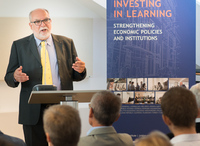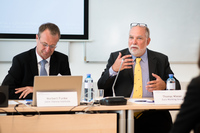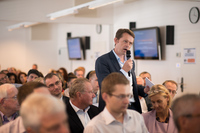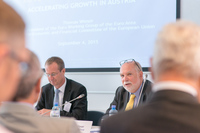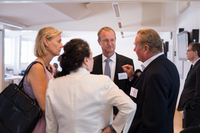Friday, September 4
Presenter
Thomas Wieser, President of the Euro Working Group of the Euro Area and of the Economic and Financial Committee of the European Union
Press Release
Summary
On September 4, Mr. Thomas Wieser, President of the Euro Working Group of the Euro Area and of the EU Economic and Financial Committee, delivered the 2015 JVI Annual Lecture. JVI Director Norbert Funke thanked Mr. Wieser for his long-standing support of the institute, as Board member, lecturer, and driving force. Mr. Funke noted that since the global financial crisis, long-term growth had declined throughout Europe, including also Austria, which trails Germany and the top three EU countries in several structural reform areas covered by the Global Competitiveness Index. The introduction provided some context to Mr. Wieser’s main thesis, namely, that to maintain Austria’s high income level as well as its competitive environment and to increase potential growth, a bold structural reform agenda is called for.
Mr. Wieser began his lecture on an optimistic note. The fact that economists have begun to discuss competitiveness and long-term global growth would be a welcome sign that the world is emerging from the crisis. To explain the low growth environment of the past few years, two strands dominate the debate. While Larry Summers predicts that industrialized countries are destined for secular stagnation, others argue instead that the slowdown is due to capital misallocation because of low interest rates. Mr. Wieser suggested a third explanation: the industrialized world has been slow to adapt to globalization and the corresponding shifts in comparative advantage.
Although Austria’s income per capita and competitive environment appear generally positive, its medium- and long-term growth prospects raise important questions. “What should be the position of Austria in the globalized economy in 20 years? And how to benefit from globalization?,” Mr. Wieser asked. In discussing reform priorities, Mr. Wieser organized his thoughts within the framework of a neoclassical production function approach.
In his view, further reforms are needed in the areas of labor markets and education. Unemployment among the young and the less qualified is high; female labor market participation, including those older than 60, is low. Austria’s educational system is relatively costly, outdated, and it underperforms in promoting talent, innovation, and inclusion. Addressing these challenges requires raising the retirement age, making policies more encouraging of female participation, and welcoming immigrants. Education should become more efficient and accessible to more people. Universities should further embrace digital technologies and teach knowledge and skills that are relevant for the 21st century and for life-long learning. And attracting and retaining highly educated individuals must become a priority.
“The large share of industrial production in Austria is a bonus; it provides a high quality of employment,” Mr. Wieser emphasized when he turned his attention to the capital factor. However, low interest rates and oil prices, a competitive exchange rate, and high demand from emerging markets have not translated into high growth because low expectations have depressed investment. In the banking sector nonperforming loans will need to be reduced, helping to create more space for private sector lending and financing real activity. Moreover, the advantage Austria had in corporate income taxation has gradually eroded: today, the complexity of the tax system implies high administrative costs. In reviewing the tax system, taxation should be rebalanced from labor to consumption. At the same time, tackling the bureaucracy should also be high on the reform agenda. Although Austria’s fiscal stance in general is still satisfactory, fiscal policy should look to shifting the composition of the budget to pro-growth spending, an area where Austria is behind some North European countries.
Mr. Wieser concluded that Austria is an economy with a high quality of employment and strong social protection. To remain so, it needs a comprehensive reform strategy to establish Austria as an innovative and inclusive economy that produces high-quality products, based on sophisticated science and R&D and supported by a dynamic service sector. At 2.8 percent of GDP, Austria’s financing of research and development should have been supportive of productivity, but the results for innovation have been somewhat disappointing — partly because the link between providers and users of R&D is broken.
A lively discussion followed. Comments ranged from the need for historical analysis, to reasons for weaknesses in competitiveness, to the effect on Austria of stalled growth in Central and Eastern Europe. In response, Mr. Wieser pointed to the period of stability from the end of World War II to the 1980s, when international trade was the main growth engine, providing for full employment and strong social protection. After that, globalization put pressure on low-wage, low-skilled sectors, leading to rapid changes in the composition of GDP. Instead of adjusting, governments opted for other options, including early retirement schemes. As a result, low-skilled employment has disappeared and put Austria in need of upgrading education for different jobs, as globalization has made structural changes ever more rapid. What has also become more important, he concluded, is the need to explain to the public the magnitude of the challenges and how they can best be dealt with.
Mikhail Pranovich, Economist, JVI


